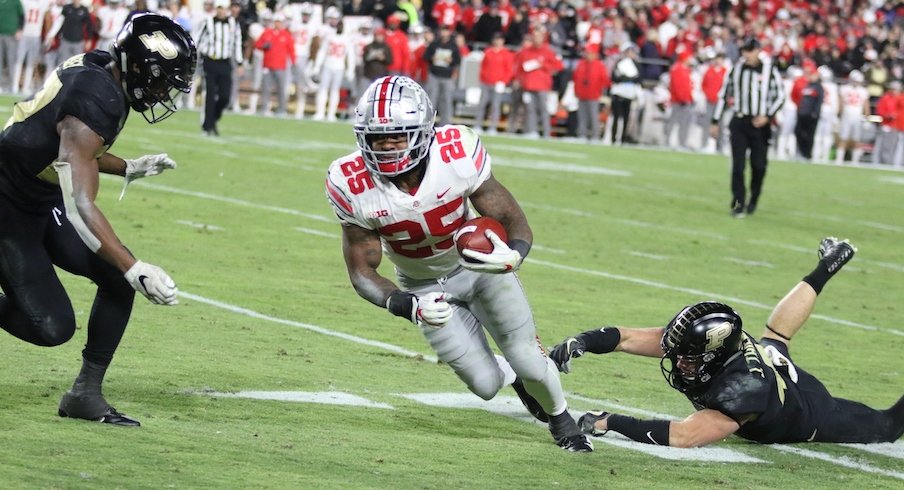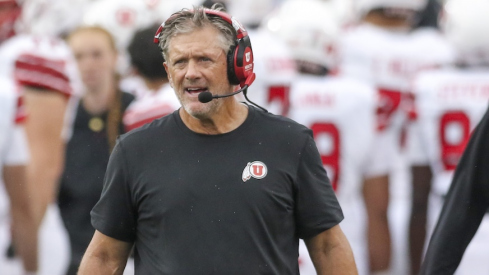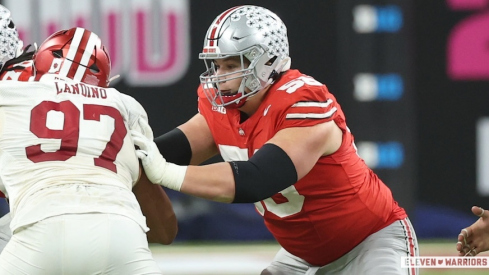The scoreboard lit up above the celebrating Purdue Boilermakers players, coaches and fans pouring onto the field Saturday night showed a 49-20 win. Almost always, that type of score means the winning team dominated in every facet of the game.
But one look at the yardage picked up by both Purdue and Ohio State shows that wasn’t the case.
The Buckeyes lost by 29 points, yet outgained Purdue by racking up 546 yards compared to the Boilermakers’ 539 yards. Ohio State had seven more first downs than Purdue, and Dwayne Haskins tossed for a school-record 470 yards. Purdue converted just 6-of-15 third downs (40 percent) compared to the Buckeyes’ 11-for-22 third-down-conversion rate (50 percent).
Between the 20-yard markers, Ohio State didn’t struggle to move the ball. But once the team reached the red zone, drives stalled.
The Buckeyes scored on just two of their five red-zone opportunities, and they kicked short field goals both times. Blake Haubeil missed his field goal attempt of the season on one trip to the red zone, and another drive stalled at the Purdue 2-yard line. The final red-zone trip ended with the clock running out to end the 29-point loss.
On Tuesday, Urban Meyer called the red zone offense one of Ohio State’s three “glaringly obvious” weaknesses, along with a lackluster run game and the defense’s propensity to allow long gains.
Meyer kept the coordinators, including Ryan Day, in town on Monday to work on the problems, including the red-zone offense. He said the staff spent at least 12 hours on Monday discussing both the offense inside the 20-yard line and improving the run game.
“I think that when we sat in here and met as an offense, we talked about how we're one of the most explosive offenses in all of college football and that statistically we're one of the most productive,” Ryan Day said Wednesday. “But now we've got to figure out how we're going to win in situational football. We've got to do a better job in that area because if we can solve that, we're really where we want to be.
“When we come in here and meet as an offense, we don't want the guys to lose that because we've done a lot of good things and scored a lot of points and gained a lot of yards. But when it comes down in there, we've got to get those problems solved.”
He’s right that they are one of the most productive offenses in the country. Even after managing just 20 points on Saturday, the Buckeyes average 43 points per game, more than any other team in the Big Ten. Haskins has begun to take down the program’s single-game records, and almost assuredly will take down the single-season passing records.
But if Ohio State can’t figure out how to make sense of the red zone, it has next to no shot at earning a spot in the College Football Playoff, let alone winning the Big Ten.
“(I’m) just frustrated that we've done so many good things, yet didn't have a lot to show for it the other night,” Day said. “We have to play better situationally because, to your point, we've done so many good things and we've got a lot of good players on offense. We have to just make sure that we're executing better in the red zone, and then when we need to be able to run the ball, we've got to be able to run the ball.”
The Buckeyes have come away with points on just 75.7 of their trips to the red zone, which is the second-lowest percentage in the Big Ten, better than only Rutgers. It puts them No. 116 in the nation, just below Tulsa and just above Western Kentucky. That’s not exactly where the No. 11 team in the nation expects to rank.
Some of the red-zone issues stem from the team’s inability to jump-start the run game, which has sputtered since a solid start to the season. On Saturday, Ohio State managed just three yards per rush, which was somehow an improvement from the prior week’s 2.88 yards per carry.
Day said the issues have been “a little bit of everything,” but noted the team should still manage to score in the red zone when it isn’t able to run. He referenced throws to Terry McLaurin and Binjimen Victor that came just inches from being completed in the end zone.
“If we make those plays, then we score and things are different. When they put the extra guy down there, we have to throw it or we have to get somebody else in there and block them. Again, looking at both of those things. But, at the end of the day, if we execute a little better, then we're OK.”
Without a J.T. Barrett-type runner at quarterback, Ohio State has been forced to view its run game differently than it had in past years, and so far, it hasn’t been successful in doing so. Teams still load up the box in the red zone regardless of whether Barrett or Haskins is at quarterback, Day said.
With Haskins, who isn’t a threat to run, though, that allows linebackers and edge rushers to crash down and focus on the running back instead of having to respect the quarterback’s ability to take off with the ball.
“When you don't have as much of a (running) threat at quarterback, then sometimes the numbers work against you. But then, that opens up the pass,” Day said. “So, when it's time to call the pass and they put the guys in there and we throw and catch the ball, we look like 100 bucks. But when it doesn't go well, then all of a sudden now we're trying to figure out how to run the ball in the red zone.
“It goes hand in hand. We've got to be able to throw the ball better and we've got to be able to run the ball better.”


